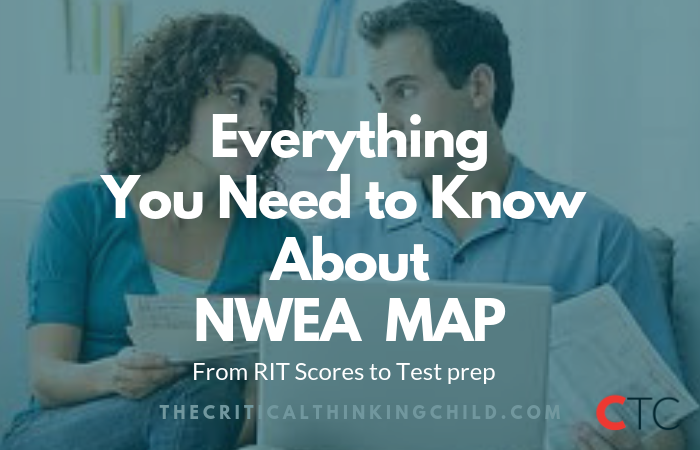NWEA Updates: How did COVID Affect Test Results?
The Northwest Evaluation Association (NWEA) recently partnered with the Center for Research on Education Outcomes (CREDO) at Stanford University to analyze fall 2020 MAP testing data. They found that student achievement dropped for most students, particularly in math. While achievement in reading was somewhat consistent with achievement from a typical school year, MAP test scores in math had a drop of 5 to 10 percentile points. This trend could explain a drop in your child’s math test scores in the last year.
Now that you have the latest research updates, let’s take a look at the logistics: the what, where, when, why, and how of the MAP Assessments.
What are NWEA MAP Assessments?
The NWEA (Northwest Evaluation Association) is the educational non-profit organization responsible for the MAP assessment. MAP, which stands for Measures of Academic Progress, refers to tests given multiple times throughout a school year to measure your student’s growth in a variety of subjects.
Kindergarten through 2nd grade students are tested in reading and math, while students in 2nd through 12th grade test in reading, language usage, math, and science. The assessment also measures college and career readiness in older students.
How are the NWEA MAP Assessments conducted?
These online tests are typically given during the regular school day on three separate occasions – at the beginning, middle, and end of the school year. Of course, this year, that has looked a little different. School districts who have implemented NWEA MAP testing have been working hard to make COVID-friendly adjustments so that the assessments can continue to be administered in a safe way. The NWEA MAP website also features practice tests that you and your child can practice with before test day.
NWEA assessments are untimed, multiple choice tests. Further, they are adaptive, which means they change based on student answers. Since all tests are given electronically, the difficulty of the questions adjusts depending on how students answer.
For example, if a student answers a question right, the next question will be harder. If a student misses a question, the next question will be easier until the student answers one correctly. This feature allows the tests to pinpoint the achievement level of each student and helps teachers plan intervention for struggling students or enrichment for students who have mastered grade-level content. Even with distance learning, teachers are able to differentiate instruction to meet all students’ needs.
These tests are used for a variety of instructional purposes. First, they offer an initial screening to get a general sense of a student’s performance. The NWEA platform then offers several tools for progress monitoring, growth measurement, and proficiency projection. They also assess skills mastery and provide teachers with research-based interventions to target specific skills or learning gaps.
What is the NWEA MAP score report?
After each assessment is delivered, you’ll receive a score report. This will show you how your child compares to peers and whether your child is at, above, or below grade level.
The score report may seem scary at first, but it’s helpful data that, once understood, is relatively simple to read. Here’s a breakdown of what to look for when you receive your child’s report:
Your child’s score report is based on what is called their RIT (Rasch Unit) score. This is a unit of measurement that reflects which skills your child has mastered, is ready to tackle next, or needs to be introduced to.
Your child’s RIT score is based on the percentage of accuracy within given skills tested. If your child answered less than 50% of questions correctly within a specific skill set, then these are considered skills that still need to be introduced. On the other hand, those questions answered at above a 50% rate of success are skills where the student is approaching mastery. The skill sets that fall within the 50% range are those that your child will most benefit from focusing on next.
Because the test is administered multiple times, you’re able to compare data and your child’s progress over the course of an academic year. After a mid-year assessment, you will receive your child’s score, their previous score, the grade level mean, and the district mean. These mean scores are presented in a simple bar graph that allows you to see how your child is performing in relation to the average score across the school and district.
In addition, you’ll see a breakdown of subcategories within each subject area. Math, for example, may be broken down into geometry, measurement and data, and numbers and operations. These are the grade level standards tested on the assessment, and you’ll see at a glance whether your child is performing at a high, average, or low level in each subcategory. There will also be a percentile that shows you how your child performs compared to other children. For example, if your child is at the 99th percentile, this means that they are performing better than 99% of other students at that grade level.
How do I read my child’s NWEA score report?
The score reports are printed in color, which makes them easy to read. Look for green highlights to show your child’s areas of strength and yellow highlights to show possible growth areas. You’ll also see an achievement score and a growth score.
Achievement scores show how your child is doing compared to the current grade level. The growth score shows how much growth your child has experienced since the previous assessment, regardless of whether they are performing at grade level or not. For example, your child may be very high in achievement but low in growth, which indicates that they are above grade level but need to be challenged more to reach their potential. Conversely, your child may be low in achievement but high in growth, meaning they haven’t hit the benchmark yet but they are progressing rapidly.
With this information, you’ll have a more in-depth view of your child’s progress. You can use the score reports to decide what questions to ask the teacher, such as asking for extra challenges or remediation opportunities. You can also use it to inform at-home activities that support your child. You may consider online tutoring outside of school if your child needs to focus on a very specific skill.
How do these scores affect my child’s experience at school?
Teachers find the RIT norm scores valuable in many ways. First and foremost, they often use these scores to help differentiate their classroom instruction. Since the tests are adaptive and the scores are so specific, teachers are able to better individualize activities for their students.
For example, if your child scores above grade level in geometry, but below in measurement, this information can help the teacher provide specific activities, independent practice, and assignments that relate to measurement. You can use this information to help your child prepare for future NWEA MAP assessments. For example, vocabulary and skills practice will help build confidence, so your child can continue to improve their scores. The scores will help you focus on those specific skills.
Some teachers may also use your child’s RIT score as a goal setting tool. For example, if your child struggles with reading comprehension, they may work with the teacher to set a goal for mastery. This type of interaction helps your child take ownership of their own learning and makes them much more motivated to achieve their goals.
These scores also help schools and districts set broad goals. The data helps provide information about how students are performing and growing as a whole. The test scores also help give teachers and administrators data to identify achievement patterns in classrooms, grade levels, and schools as a whole.
Where can I get more information about the NWEA MAP?
If you’re wondering how to take this information even further and work with your child to set goals for their education at home, the NWEA provides a Parent Toolkit. This resource is designed to help you read your child’s score report and help your child at home.
As with any assessment, the NWEA MAP provides information designed to help your child succeed. It isn’t the only way to measure success (in fact, there are many ways to do so), but the data can be valuable if you’re unsure where to start.




What does a 1% growth rate mean for a high achieving student?
Since this test is normed, 1 percentage growth may not be signficant; whereas, 1 percentile growth can be for high achieiving students.
If this tool is used to assess baseline skills and accurately measures growth – why the need for practice tests? Apparently there are ways to study to achieve a score – even though the test purports to measure growth.
Hi Toni
Thanks for your comment. Depending on the school district scores may also be used as part of high stakes testing process for selective schools. I see your point that it may not be what the test is intended for — but it is the reality for students in some school districts.
Thank you. Using my “critical thinking skills,” I assumed as much. Either academics are striving to achieve a score OR the publisher is striving to sell more products. 😌
Appreciate the validation.
Why isn’t the school giving us the test scores?
Hi Jung
Most schools will share the results with parents. However, in some cases, the results are not shared when utilizing multiple assessments for gifted and talented screening. You may want to put your request in writing addressed to the test proctor or classroom teacher with a copy to the principal.
Parents were concern about the test practice and other ways to get higher scores.
Thank you! We are happy to help!
We are grateful to have all the tools that your program offers.
Parents are concerned about the test practice and other ways to get higher scores. Your prep resources have been very helpful. Thank you!
I am suspicious of NWEA and your gun ho jump all over The New Science of Reading, which is nothing new at all. I learned to read using phonics in 1962! ALL the processes and parts of reading are important. Whole language, conversation about books. Read aloud, phonics, writing. Between Common Core and The New Science of Reading, I fear we are raising a generation of kids who will HATE READING.
I agree. Like you, we are still using the same phonics/reading tools from 1962, and it still works! 95% of our students go from nonreader to 1st grader reading level in 8 sessions. Imagine that:-)